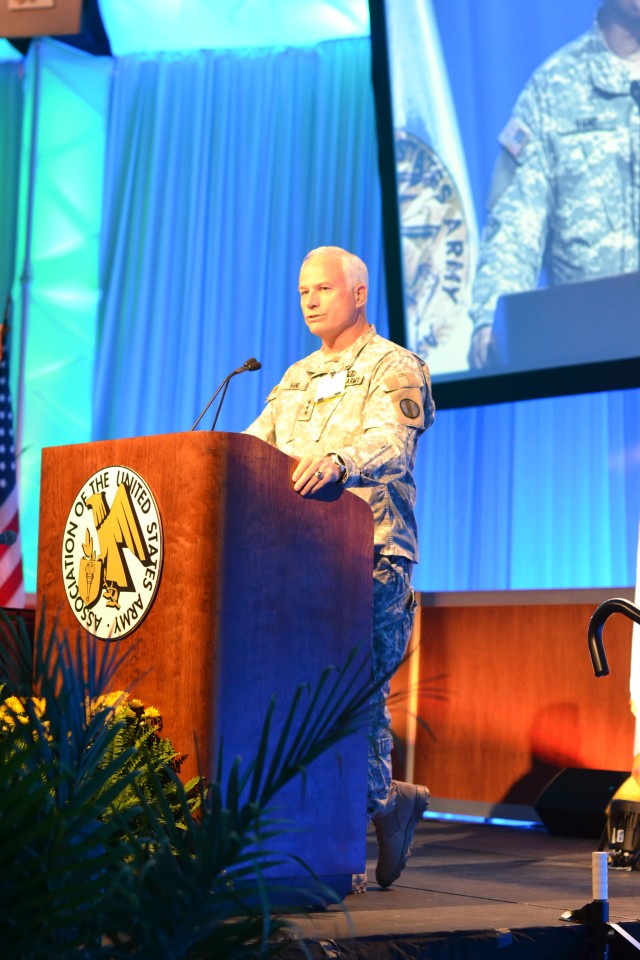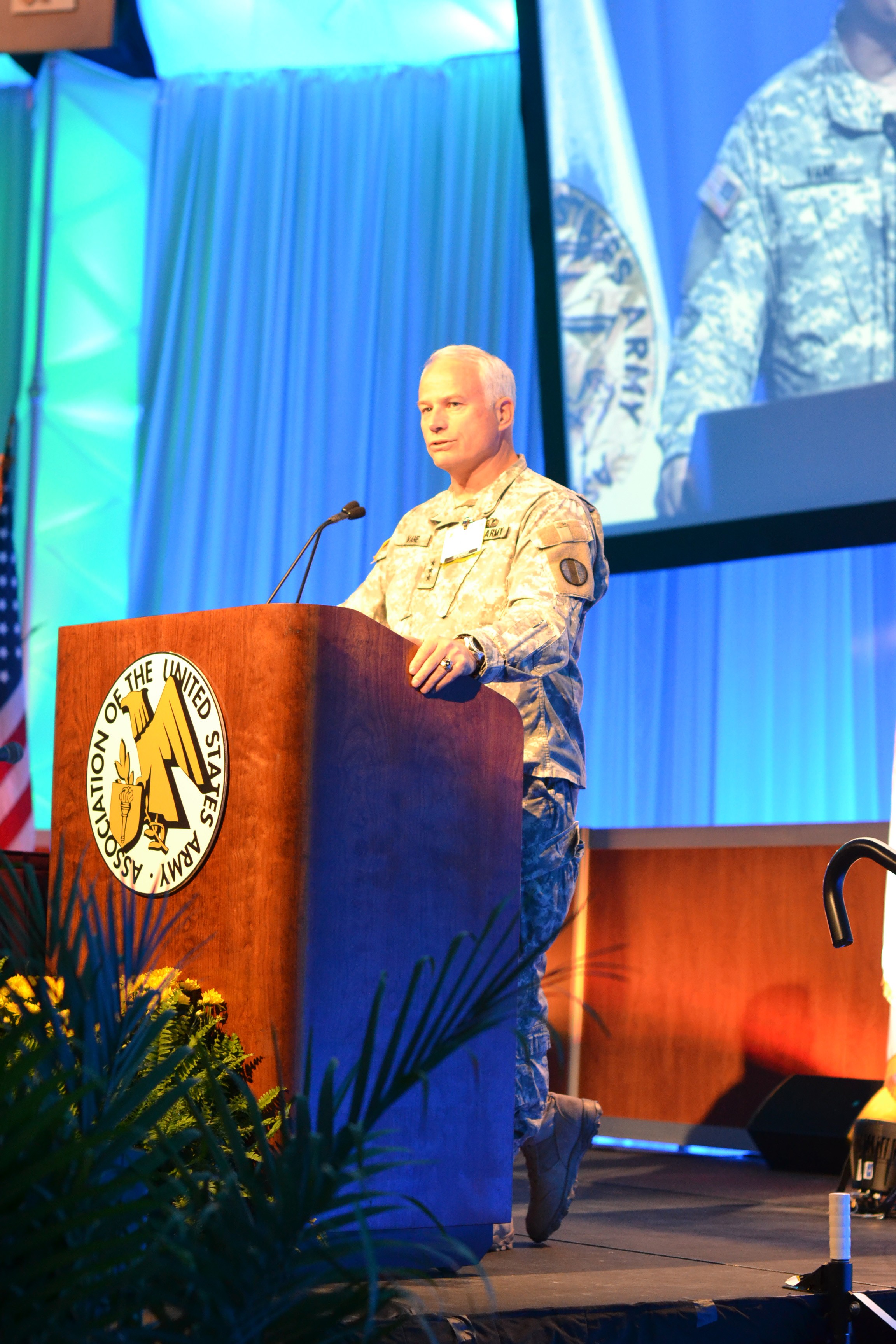
FORT LAUDERDALE, Fla. (Feb. 25, 2011) - Lt. Gen. Michael A. Vane, director of the Army Capabilities Integration Center and deputy commanding general for Futures at the U.S. Army Training and Doctrine Command, spoke about the necessity to make soldiers and small units more decisive at the Association of the United States Army Winter Symposium on Feb. 23 here.
In keeping with the Army Framework Concept, he explained that two themes of the Army Operating Concept is Combined Arms Maneuver and Wide Area Security - tasks which often requires decentralized execution of a variety of simultaneous missions within the same battlespace. The nature of these activities requires company-level and smaller elements to operate more pervasively and more frequently throughout the area of operations.
To highlight the necessity of increased roles of small units, the ARCIC commander compared today's conflict with similar conflicts from WWII. The lieutenant general explained that the Army is operating with significantly less troops in today's conflicts than in the past. He pointed out that Afghanistan is roughly the size of Texas, and the U.S. forces there number in the 95,000 range. He compared this to the invasion of Sicily, (an area equitable to the size of Vermont), in which the allied forces numbered in the 160,000 range. Additionally, the battle of Sicily was augmented with Naval gunfire - a combat multiplier not available to troops in Afghanistan.
The result of smaller forces in a move diverse operating environment is that the Army must do more with less, and one way to do that is to rely on smaller units to tackle specific slices of the mission.
The Army's reliance on smaller elements is not without due consideration. Vane explained how the individual soldier and small units must change in order to excel in their new spotlighted roles. He described how the small elements must bear lighter loads in order to move quicker, and be trained and equipped with more precise weapons in order to engage hostiles. Additionally, the individual and small unit needs to be better armored and have a greater capacity to communicate.
New and improved equipment alone is not sufficient to empower the small unit to deliver results successively in continuous operations, said Vane. The Soldier is the Army's most important asset, as such, a greater focus on the Human Dimension is also required. Vane explained Soldiers need to be physically and mentally tough. Physically -- to endure the rigors of their profession, highlighting the importance of good nutrition, building endurance and even behavioral strength. Mentally -- to remain adaptive on the battlefield while maintaining the cognitive skills to effectively leverage advanced technology to achieve the commander's intent.
The burden is not simply pushed onto the Soldier, he explained, but instead is shared by the Army. He explained how these requirements necessitate a screening process by which the Army can assess a Soldier's capability to think critically while remaining flexible and ethical.
The lieutenant general continued, explaining the need for soldiers to display strength of character, and to develop keen social skills in order to engage populations other than combatants, and to foster respect for cultures different than their own, adding that future conflicts will require interaction with allies, joint forces, various government agencies, (both our own and that of host nation), as well as civilians, and the media.
Resilience was also highlighted as a requirement. Soldiers need to be resilient in order to remain effective over long periods of time, in which the demands of multiple missions tend to drain soldiers of their energy. Vane talked about how sleep, good health and stress mitigation play important roles in building resilience.
The presentation continued with a summation of how the Army will achieve the vision of the more decisive Soldier and small unit. He talked about how recent technologies has opened up a whole host of capabilities that can connect Mission Command to elements on the ground and vice versa, ensuring commanders' intent, and allowing for better control of proportionality of effort within a given area of operations as circumstances continue to develop and change throughout a campaign.
He also talked about the "Big Five", the baseline warfighter outcomes that guide science and technology investment: Training, Mission Command, Countering IED's, Power and Energy and the Human Dimension.
Training needs to encompass live, virtual and mixed venues incorporating nontraditional techniques, especially prior to deployment, while imparting more skills that are retained longer. Training costs can be diminished by identifying of individual proficiencies and learning rates to develop more efficient programs of instruction.
Mission Command: Commanders will be challenged to broaden their line of sight to encompass activities other than what is the main focus. Also technology will be leveraged to become more mobile and to gain access to the individual soldier.
CIED: The Army will continue to improve counter improvised explosive device techniques and procedures, using Intel, technology and training of our own TTPs, as well as those trending on the battlefield.
Power and Energy: Key to the small unit remaining autonomous is the ability to operate independently, but portable fuel and power can add significant weight to the individual and unit loads. Identifying more efficient means of doing business will result in lighter loads. Additionally, the Army will identify and leverage new technology to meet power vacuums and to equip soldiers with more efficient equipment.
Human Dimension: In order to create highly skilled small units populated with the right people, the Army will put an emphasis on an individual's potential to meet the requirements, rather than rely on test scores from high school. Additionally, the Army will incorporate cognitive and physical performance enchantment into its training and be more proactive with instituting stress mitigation.
Lt. Gen. Vane summarized TRADOC efforts in two sentences, "Our most adaptable assets on the battlefield is our Soldiers," said Vane. "The direction we are headed in is to make out Soldier more protected, connected and lethal on the battlefield."

Social Sharing